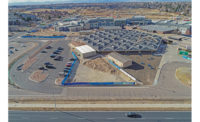Sipes says that because of the vast open space, there is often complicated and circuitous routing systems throughout the building. "Comparing it to a hospital project, it's not as enormous of a space, but [it is] equally challenging," he adds.
Through BIM modeling, the team also expects subs to emphasize prefabrication and just-in-time delivery of system elements. Pipes will be welded off site, requiring only bolting in the field. Materials for steel erection, which is currently under way and scheduled to top out in November, are limited to one day of storage on the ground before erection. The veil system, which is made up of approximately 15,000 individual pieces, will be built on a metal stud framing system that will be preassembled in approximately 10-ft by 30-ft panels, trucked to the site and lifted into place. "That takes a task that would have taken a week per elevation down to a two-day process," Sipes adds.
The intense early coordination through modeling should greatly ease challenges in the field, helping to maintain a tight schedule, Sipes say. He adds that the biggest milestone on the horizon is enclosing and finishing the bulk of the performance space before installation of the movable floor system, which Gala Systems will entirely self-perform starting in fall 2013.
"That installation is on the critical path," he says. "The heavy construction all needs to be done. Everything is focused on meeting that milestone."









Post a comment to this article
Report Abusive Comment